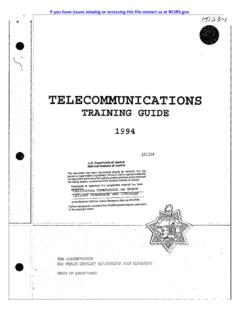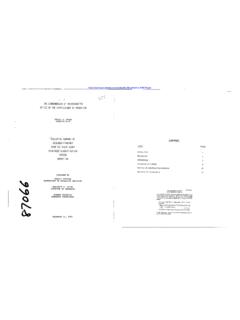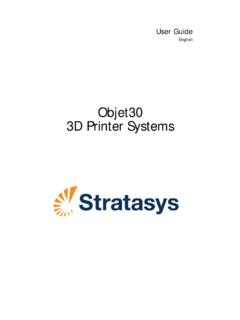Transcription of Microfluidic DNA Extraction and Purification from Forensic ...
1 The author(s) shown below used Federal funds provided by the Department of Justice and prepared the following final report: Document Title: Microfluidic DNA Extraction and Purification from Forensic Samples: Towards Rapid, Fully Integrated STR Analysis Author: Eugene Tan, Heidi Giese, and Daniel M. Hartmann Document No.: 226810 Date Received: May 2009 Award Number: 2007-DN-BX-K184 This report has not been published by the Department of Justice. To provide better customer service, NCJRS has made this Federally-funded grant final report available electronically in addition to traditional paper copies. Opinions or points of view expressed are those of the author(s) and do not necessarily reflect the official position or policies of the Department of Justice. Microfluidic DNA Extraction and Purification (2007 DN BX K184) Final Report Microfluidic DNA Extraction and Purification from Forensic Samples: Towards Rapid, Fully Integrated STR Analysis Eugene Tan, Heidi Giese, and Daniel M.
2 Hartmann Network Biosystems, 1B Gill Street, Woburn, MA 01801 This project is supported by Grant Number 2007 DN BX K184 awarded by the National Institute of Justice, Office of Justice Programs, US Department of Justice. Abstract Network Biosystems (NetBio) intends to develop an instrument for Forensic DNA analysis that fully integrates DNA Extraction , Purification , amplification, separation, and detection. Ultimately, this instrument will be used in Forensic laboratories for the rapid typing of crime scene samples. NetBio has previously developed Genebench FXTM Series 100, a Microfluidic based instrument for separation and detection of STRs, mini STRs, and mitochondrial DNA sequences. The goal of the work performed under this grant is to develop a module for Extraction and Purification of DNA from forensics samples in under fifteen minutes in a disposable plastic biochip.
3 Network Biosystems i December 31, 2008 This document is a research report submitted to the Department of Justice. This report has not been published by the Department. Opinions or points of view expressed are those of the author(s) and do not necessarily reflect the official position or policies of the Department of DNA Extraction and Purification (2007 DN BX K184) Final Report This report presents work from the 13 month program and which resulted in the successful completion of the four proposed milestones. The selection and optimization of a DNA Extraction and Purification protocol was completed with the selection of a guanidinium chloride (GuHCl) and silica based Extraction and Purification protocol for Microfluidic Purification . The selection and optimization of a DNA Extraction and Purification media was completed with the selection of a commercially available silica fiber membrane that allows Purification of DNA from large volumes (in excess of 1 ml) of whole blood with an efficiency of approximately 70%.
4 The design and fabrication of the Microfluidic Extraction and Purification biochip milestone was completed by the successful fabrication, demonstration and optimization of a Microfluidic biochip and protocol that can purify multiple samples simultaneously in 8 minutes. The biochip has a demonstrated capacity of over 10 g, and a Purification efficiency of over 50% for blood input volumes of less than 100 l. Biochip DNA Extraction and Purification from mock crime scene and database samples was completed with the successful DNA Purification and subsequent successful inhibitor free multiplex PCR amplification of blood, saliva, and cellular samples from cotton swabs; touch samples from cotton swabs; blood, and saliva on cotton, denim, and polyester; and buccal cells from swabs. The findings of this work will be disseminated to the Forensics Sciences community in an oral presentation entitled DNA Purification From Forensic Samples in a Microfiuidic Biochip at the 61th Annual Meeting of the American Academy of Forensics Scientists in February 2009.
5 Network Biosystems ii December 31, 2008 This document is a research report submitted to the Department of Justice. This report has not been published by the Department. Opinions or points of view expressed are those of the author(s) and do not necessarily reflect the official position or policies of the Department of DNA Extraction and Purification (2007 DN BX K184) Final Report The end result of this program is the successful development of a Microfluidic biochip that is capable of purifying DNA from a variety of sample types and substrates relevant to the Forensic sciences community. Furthermore, the successful development of this module represents the completion of another critical step in the development of a fully integrated instrument. Network Biosystems iii December 31, 2008 This document is a research report submitted to the Department of Justice.
6 This report has not been published by the Department. Opinions or points of view expressed are those of the author(s) and do not necessarily reflect the official position or policies of the Department of DNA Extraction and Purification (2007 DN BX K184) Final Report Table of contents Abstract .. i Table of contents .. iv Introduction .. 1 Research 16 Materials and Methods .. 18 Conventional DNA Extraction and Purification 18 Biological Samples .. 24 Mock casework and mock database samples .. 24 Biochip DNA Extraction and Purification protocol .. 27 DNA analysis 28 Results and Discussions .. 32 32 Initial Microfluidic biochip design for fluidic functionality and initial DNA Biochip Extraction and Purification from forensically relevant mock crime scene and DNA Purification from mock casework samples biological material on natural and Design and fabrication of 16 lane Extraction and Purification biochip.
7 39 39 Optimized Extraction and Purification biochip and 51 database samples.. 58 DNA Purification from mock casework samples biological material on swabs.. 58 synthetic 67 DNA Purification from database or reference samples buccal cells on swabs .. 71 79 81 Network Biosystems iv December 31, 2008 This document is a research report submitted to the Department of Justice. This report has not been published by the Department. Opinions or points of view expressed are those of the author(s) and do not necessarily reflect the official position or policies of the Department of DNA Extraction and Purification (2007 DN BX K184) Final Report Introduction A fully integrated instrument that will provide sample in to results out Forensic DNA analysis will dramatically reduce the costs (including labor, space, and validation) of establishing and operating a Forensic DNA lab.
8 As importantly, this instrument would offer new capabilities for law enforcement by enabling DNA to be analyzed in a fraction of the time currently required. Network Biosystems (NetBio) is developing an instrument for Forensic DNA analysis that will generate an STR profile in 45 minutes or less following sample introduction. The features of the instrument include: Ease of use. Current DNA sequencing and fragment sizing instruments are difficult to use and require highly trained operators. The fully integrated system in development would essentially eliminate all manual processing sample would be introduced and a button pressed. As a result, only minimal training would be required, and a high school graduate would qualify as an operator. Single use disposable biochips. In Forensic DNA analysis applications, the presence of even trace amounts of contamination can lead to spurious and potentially catastrophic outcomes.
9 The single use disposable biochips in development would minimize the risk of contamination. Disposables would also eliminate Network Biosystems 1 December 31, 2008 This document is a research report submitted to the Department of Justice. This report has not been published by the Department. Opinions or points of view expressed are those of the author(s) and do not necessarily reflect the official position or policies of the Department of DNA Extraction and Purification (2007 DN BX K184) Final Report the need for cleaning and reprocessing of biochips, labor and cost intensive procedures. Similarly, the biochips are being designed to contain all necessary reagents on board without the need for manual reagent reconstitution. Time to answer. In general, the faster the result becomes available, the better so long as the data is complete, accurate, and reliable.
10 For human identification applications, an appropriate time to result is 45 minutes or less, well under the days to weeks required using conventional technology. The underlying goal is to generate actionable data in real time. A short time to answer would also allow a concomitant increase in sample throughput. Miniaturization. Many DNA analysis systems require an entire laboratory and related support. Miniaturization is important both for laboratory and point of care use as well as field operation. A small footprint allows an instrument to be placed almost anywhere; even in a large laboratory, miniaturization increases process capacity. In the field, a small instrument is required for portability. Closed system. Once the sample has been introduced, no direct operator manipulation will be possible. This approach minimizes the possibility of sample contamination and, just as importantly, leads to consistency and reproducibility of operation across personnel and laboratories.



















